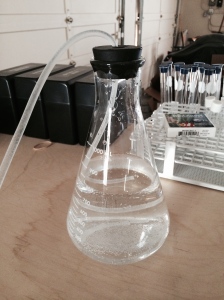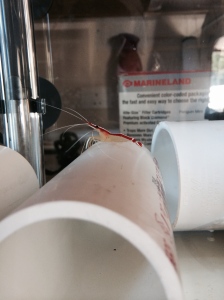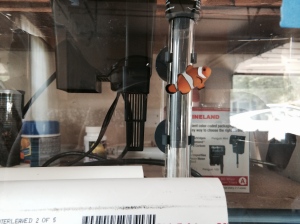
A test drive device using a 1000mL Erlenmeyer flask, a length of air pump silicon tubing, and a T-valve.
After a month of quarantine, Candy the shrimp finally was able to molt enough times to rid himself of the black marks visible on/under his carapace. The marks on the top of his carapace were believed to be bruising of some kind, but the black dots on his gill area were more troubling. We believed they were some kind of bacterial or fungal infection based upon reading, but obviously could not test. Now that they are gone, Candy was moved to the display tank, and hangs out with Plato in the same overhang.
With that quarantine tank empty, I cleaned it, and reset it with a hyposaline salt-water mix at 12ppt. I just bought a second Percula clown fish, just named Philip. Philip does looks quite similar to Christopher, the Percula clown we bought a month ago, and may even have been from the same batch of fish. However, they are distinguishable due to the differences in their stripes, Philip has an uneven white stripe on his tail, where Christopher has a much more even stripe.
I also have an outdoor pond at my house, which is approximately 150 gallons. Today I had the epiphany to put a freshwater turtle in there as I have always loved turtles but obviously cannot possess a salt-water marine turtle. It turns out an aquarium store in the area does carry freshwater turtles, and we bought a eared slider turtle, a common and tough species that is native to the southern United States and Mexico. His name is tentative, but Anna and I are debating between George (as in curious) or Thomas.
Finally, I tested a DIY drip device composed of a length of air-pump silicon tubing (3/16″), a T-valve to regulate flow, and a container. In my case, I had a 1000mL Erlenmeyer flask with rubber stopper that contained a hole for the tubing. Unfortunately, these stoppers have two holes, one for the tubing and another smaller one for purposes unknown. It is not entirely air tight, but any container can be fashioned and used for this purpose. In my case, the Erlenmeyer flask is easily washed, and it beats sterilizing a 2 liter soda bottle. The tubing and a similar valve are both available from Amazon.
I am deciding whether I want to start culturing my own plankton food. I do enjoy building things, but I am not sure I want to spend the time culturing constantly. This DIY article has a nice looking design for a cheap PVC stand to culture plankton. My other option is to buy a concentrated bottle (such as Phytofeast or Tahitian Blend. Note that Brine Shrimp Direct gets all their algae pastes from Reed Mariculture which is the company that makes Phytofeast) and then disperse into the aquarium as needed. I am basically torn between the convenience of the bottles, vs. the higher cost due to repeated shipping and handling. Lastly, the live culture does have the possibility of some plankton surviving in the display tank, finally allowing me to successfully raise a Nassarius snail from veliger to juvenile, something I have wanted to do for years.


